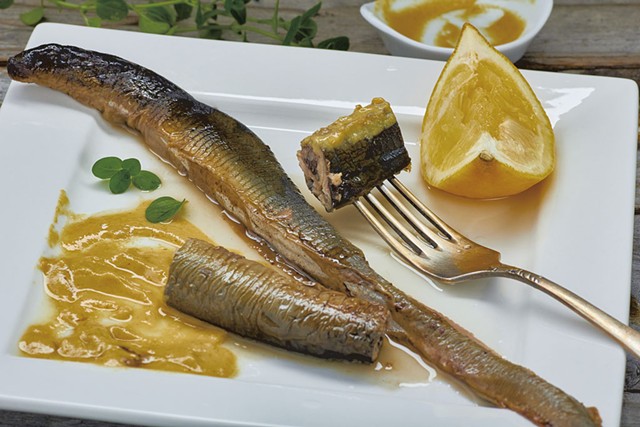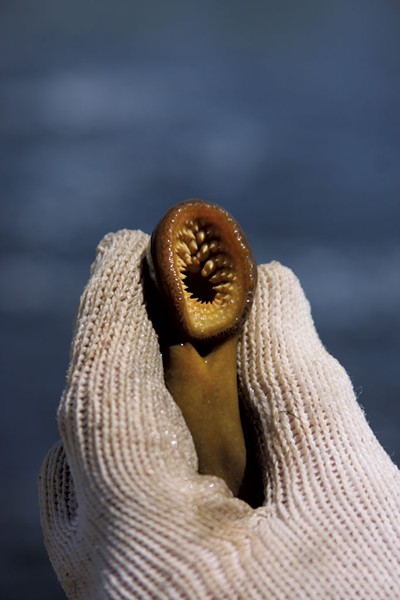
- © Roberts Resnais | Dreamstime
- Stewed lamprey with mustard and lemon
Imagine a beast from deep waters that resembles the hybrid of a leech, an eel and your worst alien nightmare. The creature boasts rings of teeth that latch on to flesh to suck the blood of its prey.
Now imagine eating it for dinner.
Michael Tessler is no stranger to bloodsucking monsters; he's an expert on leeches and also studies sea lampreys. The assistant professor at St. Francis College in Brooklyn and American Museum of Natural History research associate attended Sterling College in Craftsbury, where he is a board trustee and frequent guest teacher.
Tessler understands that sea lampreys are despised by many Vermonters, especially those who fish, because they harm trout and salmon in Lake Champlain with those fearsome mouths.
The origin of sea lampreys in Lake Champlain is a mystery. Some historical evidence suggests that they were introduced through the Champlain Canal sometime after 1916. But genetic evidence indicates that the lake could harbor an indigenous population dating back more than 10,000 years.
There are at least four species of lamprey in Vermont, several of which are not even parasitic. Sea lampreys are parasites — hence their spooky nickname, "vampire fish." The species is native to the Connecticut River basin and plays a vital role in the ecosystem, according to the Vermont Fish & Wildlife Department.

- Courtesy Of Karla Bartlett/u.s. Fish & Wildlife Service
- Sea lamprey
However, their abundance and the damage they cause has made the fish a target of a biological control program, which includes the controversial use of lampricide that can also be harmful to other species.
By contrast, Tessler noted that in many regions and throughout history, lampreys have been treasured and protected. In Wired magazine last year, he wrote, "To ancient European elites, sea lamprey was a delicacy, with a scallop-like texture and an earthy taste. Julius Caesar rewarded his men with lampreys at banquets to celebrate victories."
Lampreys are still eaten in parts of Europe, and Tessler said he knows a Cornell University professor who cooks lamprey Bordelaise for students annually. But, so far, no Vermont restaurant is serving lamprey chowder.
This raises the question: If sea lampreys could be fished and eaten, might that help control their population?
Seven Days recently discussed this and other slippery sea lamprey questions with Tessler.
How did you first become interested in sea lampreys?
I did my PhD on leeches. While sea lamprey are fishes instead of worms, they are functionally supersized leeches. Witnessing sea lampreys breeding in streams is a magical experience. They are large fish for a stream but are camouflaged. They are hyper-focused on breeding, so you can touch or pick them up. They improve ecosystems by bringing nutrients from oceans to freshwater bodies, as salmon are famous for doing. Maybe most people don't get excited about scooping up a two-foot-long, eel-like fish, but it really brings out the frog-catching inner child in me.
What have you learned about lampreys in Vermont?
Sea lamprey populations have a fundamental contradiction: Many of their native populations are crashing due to environmental degradation, but the populations in their non-native range are invasive and are targets for removal.
While the Lake Champlain population of sea lampreys is generally reviled, the native population in Vermont's section of the Connecticut River and its tributaries has largely been ignored until recently. These natives bring nutrients all the way from the Atlantic Ocean to Vermont and then die after spawning, which boosts the local ecosystems.
Why don't more people eat lamprey, particularly in the United States?
It's not only that Americans are squeamish about eating sea lamprey; it turns out that lamprey in U.S. waters have too much mercury. They are parasites of top predators, so if those predators have much mercury in them, then the lamprey winds up with even higher concentrations of mercury. It is classic bioaccumulation.
So, sadly, we can't easily eat away this invasive species problem.
This interview was edited and condensed for clarity and length.











Comments
Comments are closed.
From 2014-2020, Seven Days allowed readers to comment on all stories posted on our website. While we've appreciated the suggestions and insights, right now Seven Days is prioritizing our core mission — producing high-quality, responsible local journalism — over moderating online debates between readers.
To criticize, correct or praise our reporting, please send us a letter to the editor or send us a tip. We’ll check it out and report the results.
Online comments may return when we have better tech tools for managing them. Thanks for reading.